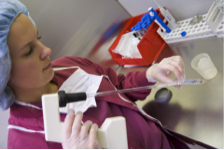Investigation of infertile couple
|

|
The initial infertility workup includes a series of tests that must be performed when the couple visits the Gynaecologist for the first time.
Medical history

The first visit to the Gynaecologist includes a comprehensive evaluation of the couple’s medical history, including aspects that may not be gynaecological in nature.
Factors that should not be omitted include:
• the couple's age
• previous pregnancies (including previous miscarriages or children with the same or a different partner)
• medical conditions associated with infertility (endometriosis, surgery, fibroids, the nature of the menstrual cycle, etc.)
• history of male partner (smoking, alcohol, urological diseases, infections, pain, etc.)
The frequency and timeliness of the couple's sexual intercourse in relation to ovulation will also be discussed.
Ultrasound
A transvaginal ultrasound will provide the necessary information regarding the internal anatomy of the female reproductive organs and an antral follicle count (AFC) will reveal the "ovarian reserve" within each ovary. The ovarian reserve is an indication of the ovary's capacity to produce oocytes during an assisted reproduction cycle.
Hormonal evaluation
A hormonal evaluation provides additional information concerning ovulation and ovarian reserve, as well as an overall hormonal profile of the patient. The hormones monitored are FSH, LH, estradiol and progesterone. In recent years AMH (Anti-Mullerian hormone) has gained ground when it comes to assessing ovarian reserve.
The following hormones are also monitored: TSH, T3, T4, Anti-Tpo, Anti-TG, prolactin, testosterone, SHBG, Androstenedione, DHEA-S.
Semen analysis

A semen analysis evaluates the primary characteristics of a semen sample, including sperm (spermatozoa) count, as well as their motility and morphology.
In 2010, the World Health Organization described the parameters of a normal semen sample as follows:
• volume of ejaculate > 1,5 cm3
• concentration of spermatozoa > 15 million / cm3
• good motility ≥ 32%
• normal morphology > 4%
Abnormal semen samples are classified as follows:
• Hypospermia : volume is less than normal.
• Azoospermia: the absence of spermatozoa in ejaculate.
• Oligo-zoospermia: sperm count is below 15 million / ml.
• Astheno-zoospermia: poor motility.
• Terato-zoospermia: increased presence of spermatozoa with abnormal morphology.
Seeing as the normal criteria for a semen sample are relative (expressed in terms of concentration and percentage) the final diagnosis is made by a qualified Biologist or Gynaecologist.
Prior to a semen analysis, abstinence is required for 2 to 5 days. It is also recommended that the analysis be repeated after 2 – 3 months.
A normal semen analysis does not guarantee that the male is fertile. There are a number of other underlying factors associated with male infertility, such as chromosomal abnormalities, DNA anomalies, etc.
Similarly, an abnormal semen analysis does not always indicate male infertility. In case of an abnormal result, the patient is referred to a qualified Urologist Andrologist in order to identify and address the problem.
e-webtools
News
After 16 years of trying to have a baby, our dream became reality!
Irini - Babis
Edessa 25/1/2012






